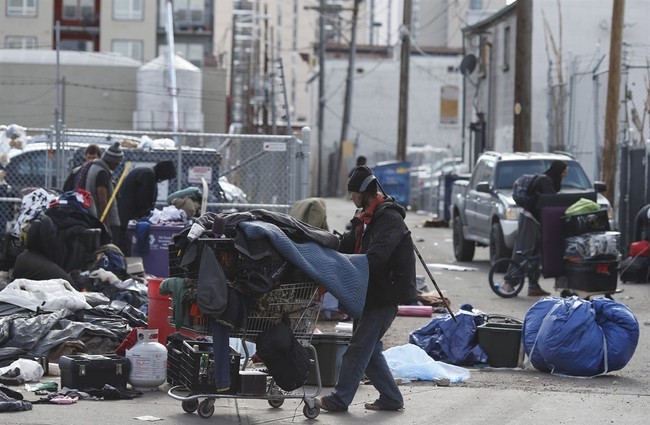
Colorado used to be a pretty neat place. For years, you could have described it as South Wyoming. It was a state where miners and ranchers still held a lot of influence, where if you went up to places like Middle Park or the Uncompahgre, it wasn’t unusual to see authentic Western types with big hats and belt buckles – and big revolvers on their belts.
No longer. Colorado, a place which was my home for 30 years, is now East California. The Denver-Boulder Axis has taken over the state, and now the Denver area is paying the price with an explosion of homelessness – in fact, a 90 percent increase in the last five years.
Colorado has seen the fourth highest percentage increase in homelessness in the U.S. since 2020, according to a new report.
The report, by the free-enterprise Common Sense Institute, also called into question most of the state’s “housing first” approach, saying it “may not be the best approach to addressing this challenge.”
Colorado’s homeless population increased by 90% since 2020, ranking behind only Vermont (212%), Illinois (148%) and Rhode Island (121%). According to the report, the state’s 3.14 homeless per 1,000 residents ranks ninth nationally.
Note the one thing that these states all have in common: They’re all blue states. Now, blue states don’t have a monopoly on this problem. Even here, in Alaska, the city of Anchorage has a growing homeless population, which is all the more baffling given the winter temperatures. And even in Anchorage, the trash-strewn encampments have the added possibility of attracting grizzlies.
Back to Denver: There’s one factor that might explain this sudden increase:
In the combined Denver-Boulder-Aurora area, $405 million in local, state, federal and nonprofit funding was spent in 2023 to combat homelessness, CSI noted.
Denver had a record-high 9,977 unhoused individuals in 2024, according to point-in-time counts. Of those, 2,233 individuals participated in Denver’s “housing first” All in Mile High Program, which cost $69,413 per person and an additional $16 million on those who became unsheltered after leaving the program, the report said.
“This report makes clear that homelessness is growing fastest in cities most reliant on housing-first strategies,” said Dustin Zvonek, CSI’s research fellow on homelessness and a former Aurora City Council member. “We need to step back and look at the broader data — ask what’s working, what’s not, and focus on implementing policies that deliver measurable, sustained improvements.
There is an unshakable law of economics: What you subsidize, you get more of. And Denver, Boulder, and Aurora are spending a lot of taxpayers’ money trying to house these people, many of whom are unhouseable, due to mental health issues, addiction issues, or some combination of the two.
The traditionally conservative El Paso County is having a better go of it:
The think tank also contrasted Denver’s “housing first” approach with El Paso County’s (Colorado Springs) and Aurora’s “work first” approach. In El Paso County, the point-in-time count for last year was 1,146 homeless individuals, 12% less than the prior year.
Denver and Boulder, it seems, are taking their cues from California, and they’re getting the same results.
See Also: Feds Investigating Los Angeles Homeless Industrial Complex Spending – Here’s How We Got Here
For “housing first,” though, I would substitute “sobriety first,” even if that means removing the more mentally ill and seriously addicted off the streets involuntarily. There is ample evidence of substance-abuse problems among the homeless, along with the crimes committed to support those habits. That’s the first thing that has to change: Sobriety, then work, then back to being a productive member of the community.
There are also those with serious mental illnesses who may never be able to be productive. Upon a time, there were institutions for people like this, but legal wrangling has largely ended that practice, which frankly seems kinder than leaving the seriously ill on the streets.
The Denver area was our home for many years. We raised our family there. Our four daughters still think of that area, in many ways, as “home.” Colorado still has much to recommend it, especially in the wilder areas. It’s a beautiful place, but the left has made it unlivable. The Denver-Boulder Axis will continue to have these problems with rampant homelessness as long as they continue throwing money at it with no notion of trying a different approach, and their problem will only grow worse.
Colorado has truly become East California, indeed.
President Trump is leading America into the “Golden Age” as Democrats try desperately to stop it.
Help us continue reporting on President Trump’s success. Join RedState VIP and use promo code FIGHT to get 60% off your membership.

















